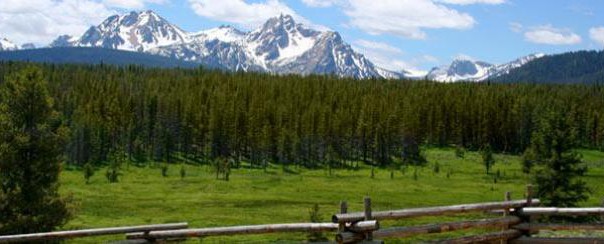Understanding our Forests
Idaho has some of the most beautiful and pristine forests in the United States. For decades Idaho foresters have dedicated their lives to maintain the health of our forests but are now faced with an agenda of destruction. Part 1 introduces the reader to the history and constitution of the lodgepole pine, the Targhee National Forest, and forest management practices up to 1980. The purpose is to understand what management practices are needed for forest health. For anyone who loves the forest this first part is the beginning introduction to understanding how our forests are being destroyed.
Who owns Idaho forests? According to Idaho Forest Products Commission the United States Forest Service (USFS) and Bureau of Land Management (BLM) own 79%, or 17.3 million acres; corporations, Tribes, and Family Forest Landowners own 15% or 2.6 million acres; and the State of Idaho owns 6%, or 1.5 million acres through State Forests and State Parks. The objectives of these different groups vary, from producing wood products, promoting wildlife habitat, and promoting a mix of environmental and economic values.
Historically, the federal government expanded the amount of land and their control over Idaho forests from as early as 1906 with local opposition at the same time, and which continues today. Since that time the government has continued to expand their control over other Idaho forests.
The characteristics of Idaho forests vary so for the purpose of this article the focus will be on the lodgepole pine as it is a widely distributed species in Idaho. In order to understand how our forests are being destroyed it is important to understand the constitution and care of forests that contribute to forest health.
According to the USFS, some constitutional aspects of the lodgepole pine include its ability to thrive in a wide variety of topographic situations, grow in pure stands and with other western conifers, tolerance of different environmental factors, and being a prolific seed producer especially in clearcuts where cones attached to the slash scatter seeds over the forest floor when knocked down during slash disposal. Another unique lodgepole feature is its ability to regenerate after a fire as the cone releases seed at high temperatures, but it does not require fire to regenerate. During early growth lodgepoles require good sunlight and absorb higher concentrations of carbon while a dead tree emits almost all of its stored carbon into the atmosphere. Lodgepoles show good response to thinning at an early age (17), with poor sites and overstocked stands requiring thinning as early as age 10. Along with thinning, lodgepoles need a clean forest floor, free from excessive debris, slash, and grass in order to regenerate.
Detriments to lodgepole regeneration include intolerance of shade, excessive grass or slash which inhibits seed germination and survival, overstocking, stand density, and competition from other plant species. Mountain pine Beetle epidemics also destroy vast acreages of lodgepole.
The mountain pine beetle, a natural forest species, is the most severe insect pest of lodgepole pine. Harvesting is considered a preventative measure for mountain pine beetle epidemics as the beetle will migrate to adjacent stands. Another pest to the lodgepole is the pine engraver which develops in logging slash, especially slash that is shaded and does not dry quickly. Prompt slash disposal is an effective control measure along with clearcutting and locating unit boundaries to minimize reinfection from surrounding stands. Mortality from beetle epidemics often creates large amounts of jackstrawed fuel that ignites easily from lightning and other sources, which in turn hamper fire control efforts.
There are different methods of harvesting forest wood. Clearcutting removes all trees in a stand; seedtree removes the majority of mature trees; shelterwood is selective harvesting; group selection harvests mature trees and thins intermediate trees; and single tree selection a highly selective system removal of individual trees, leaving the majority of the trees on a site standing while removing dead and diseased trees from the forest. It is important to understand harvesting methods as variables such as tree species, age, diseases, and restoration determine which harvesting method is used, and can be a source of conflicting views.
Idaho has a history of protecting its forests. In the 1940’s the Keep Idaho Green campaign was launched to educate the public on preventing forest fires. In 1950 Idaho introduced the Guberif as a reminder for Idahoans to exercise responsibility while enjoying our forests and prevent forest fires. The Guberif was a huge success, seen everywhere, and was a symbol children understood.
By the 1960’s the Targhee National forest was overgrown and considered to be full of old growth. Because of a mountain pine bark beetle epidemic and increased fire hazard a forest restoration project was started in the 1970’s to clear the forest of old growth and plant new trees, while putting the deadwood to good use.
The proper maintenance of lodgepole pine is discussed in this 1970 research paper stating, “Maintenance of lodgepole pine forests requires both a greater understanding of the continuing biological processes and a high level of management”. Historically pine beetle epidemics have occurred multiple times, as early as 1870 to present, attack the largest, or older, trees first, then moving to smaller trees or adjacent stands. A forest destroyed by the pine beetle is more susceptible to fires and loss of residual trees due to windthrow, and the cost of firefighting is doubled. According to this paper the probability of a stand being infested in Targhee appeared to be rather high. Suggested management practices to reduce pine beetle epidemics were to replace lost lodgepoles with a different tree species, tree size rotation, and plant species and age class mixtures.
By 1980 more was understood about protecting the lodgepole from beetle epidemics. This research article references necessary forest health to protect watersheds, game habitat, and provide raw materials. Often lodgepoles regenerate too abundantly causing dense stands that inhibit their own and other species growth, and young lodgepole growth which need sun for rapid growth. The report also recognized that “Plans developed to prevent or to reduce mountain pine beetle population buildup in lodgepole pine stands must consider renewable-resource silviculture.”
To reduce beetle epidemics at the time of this report several methods were recommended. Type Conversion is the replacement of a lodgepole with another species such as a Douglas-fir to serve water-shed management and other purposes. It could be accomplished naturally through culturing the understory or artificially by cutting, then planting or seeding the desired species. Other recommendations included Short Rotations or selecting trees for product requirements, creating mix species stands, age and species mosaics, stock control (a method of single tree selection), repeated thinning, partial cuts, and clearcutting being the best management practice. A “do nothing” approach was also reviewed and was found to be the most detrimental where, “the infestation continued, and 39 percent of the trees, or 52 percent of the basal area, was lost to the beetle.” One other side effect of this devastation is the release of carbon from dead trees. The first 5 years after harvesting were very encouraging in reducing beetle epidemics.
In the discussion of fires, 2 methods out of 6 found either to be favorable regarding the pine beetle. “Allow “safe” lightning fires to burn, allow for some other wildfires that cannot be controlled, but prescribe enough additional controlled fires to assure the natural fire regime…which would provide approximately the natural fire regimen and avoid the risk of letting wildfires get out of hand before control is attempted.” Secondly, “suppress all wildfires to the extent feasible, and duplicate the natural fire regime with prescribed-controlled fires.” Fire suppression was to be used concomitantly with other practices such as thinning, harvesting, and prescribed burns. Another adverse effect of forest fires is the release of carbon into the air.
Most interesting of all was number 6. “Abandon the ideal of natural ecosystems and turn to full-scale vegetation and environmental manipulation by mechanical and chemical means, seeding, planting, and so on. Attempt to produce desired vegetation with the tools of applied forestry.”
Recommended management objectives included a three-phase harvest program over a 21-year period, clean up the mess and reduce the fire hazard, mitigate adverse effects on soil, water, and wildlife, regenerate stands quickly, and utilize wood fiber, thereby maintaining the forest and its resources.
In summary, focusing on the lodgepole pine and the Targhee National Forest in Southeast Idaho, efforts on the part of Idahoans to mitigate the loss of our forests to fires and pine beetle epidemics prior to 1980 included specific forest practices of harvesting trees and protecting the other forest attributes such as wildlife and watersheds.
The destructive policies and imposed regulations contributing to the destruction of our forests will be explained in part 2.



